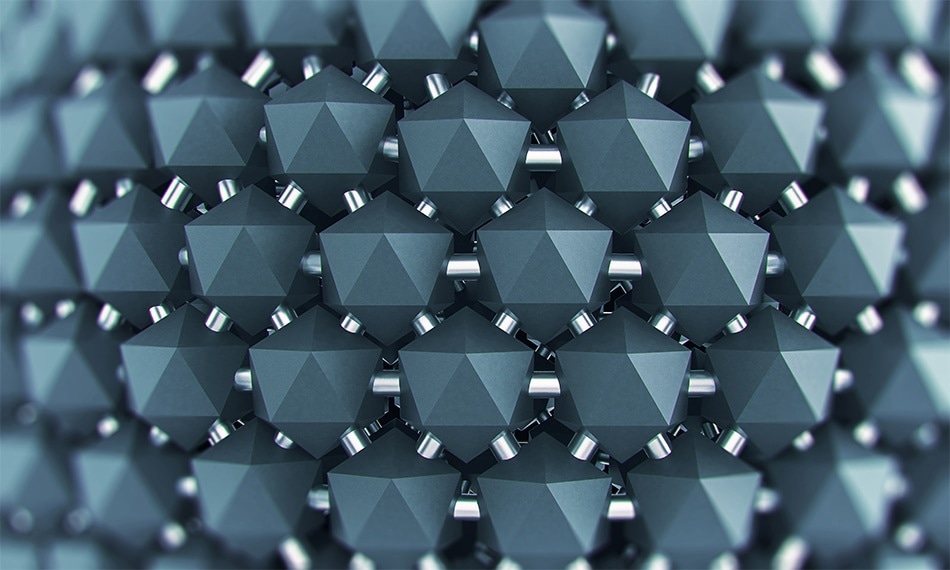
Image Credits: AnnaKireieva/shutterstock.com
Graphene nanoribbons (GNRs) are narrow strips of graphene measuring at only a mere billionth of a meter wide. The quasi one-dimensional nature of GNRs presents some additional advantages over graphene.
The free flow of electrons and the lack of energy gap makes graphene unsuitable for using it for turning the current on and off1. Graphene sheets are exceptional conductors of electricity, while GNRs that are made by narrowing graphene act like a semiconductor if the ribbons are made with specific edge shape.
Graphene is a two-dimensional allotrope of carbon comprised of a single thin-layered sheet of tightly packed carbon atoms that are arranged in the vertices of a hexagonal lattice resembling a honeycomb.
Despite being the thinnest single atom tick material known to man, graphene is 100 – 300 times stronger, and its extremely light weight measures at only 0.77 mg per square meter1. The electrons in the graphene can travel at great velocity and is considered as the best conductor with electron mobility measuring at 15000 cm2/V/s. The p- band and p* bands formed by the hybridization of p bonds are responsible for these special electronic properties2.
Due to graphene’s unique levels of visible light absorption, it could potentially be used in spin transport.
It is due to graphene’s exceptional electrical, mechanical, optical and thermal properties, as well as its ecofriendly nature, that has made it an area of intense research in the fields of electrical, electronics and material sciences. Some of its applications within these fields include light emitting diodes, supercapacitors, batteries, transparent conductive films, catalytic systems, smart windows, touch panels, wearable devices and many more1, 2, 3.
As impressive as it sounds, graphene is not yet commercially used due to the difficulties in preparation of high quality graphene on a large scale in a cost-effective manner.
Depending on the synthesis method of GNRs, the structure and physicochemical properties of GNRs vary greatly between each other4. There are three major methods by which GNRs are produced. For example, lithography is a process of cutting GNR from graphene on a substrate surface. While this method allows for the production of highly precise and very narrow GNRs, it has its limitations4.
The limitations of this process include failure to produce bulk quantities, limiting applications to where GNRs can lie flat on a surface as well as the production of jagged edges that make it difficult to control its electronic properties4.
Unzipping is the second method where GNRs are prepared, which involves the longitudinal opening, or ‘unzipping,’ of multi-walled carbon nanotubes (MWCNTs), which are comprised of two or more layers of cylindrical carbon nanotubes enclosed in one another of increasing diameter. The unzipping techniques are solution-based, and therefore have unique advantages of mass producing capabilities at lower costs4.
The third method used to produce GNRs is the ‘bottom-up fabrication method,’ where GNRs are synthesized by multistep organic synthesis, based on the cyclization of polymer chains. Very narrow GNRs with atomically precise edge configurations can be synthesized by this method4. Until recently, GNRs produced by this method were only able to be prepared on top of a substrate, which severely limited the potential of this method to mass produce GNRs4.
Scientists at the Oak Ridge National Laboratory (ORNL) Center for Nanophase Material Sciences in collaboration with North Carolina State University have developed GNRs without the use of metal substrates5. While previous researchers has used metal substrates to catalyze a chemical reaction, Chuanxu Ma’s team injected charge carriers (holes) from a scanning tunneling microscope (STM) tip to promote a chemical reaction that converts a quasi-free standing polymer precursor into a GNR5.
This technique allows for the creation of interfaces between the materials of different electronic properties, which often form the basis of semiconductor electronic devices such as integrated circuits and transistor light emitting diodes and solar cells5.
In the method used by Chuanxu Ma’s team, the hole injection assisted reactions to produce GNR occurred at selective molecular sites which could be controlled by STM tip, whereas catalytic cyclodehydrogenations typically happen in a domino-like conversion process during the thermal annealing process6.
This novel controllable bottom-up method to synthesize GNRs lowered the energy barrier in the key step of C-C bond formation and the hydrogen atoms migrated to the edge and escaped into the vacuum as molecular hydrogen (H2) 6.
The polymer-GNR intraribbon heterostructures created have a type-1 energy level alignment and strongly localized interfacial states6.
This new bottom up fabrication method for synthesis of controllable synthesis of freestanding graphitic layers can be scaled up and automated5. This group of researchers believe that it is a great wat to tailor physical properties of graphene based materials for energy applications and they are now working on making heterojunctions with different precursor molecules and explore functionalities5.
References and Further Reading
- "Graphene - What Is It?" Graphenea. Web. https://www.graphenea.com/pages/graphene#.WKYtFhiZPdQ.
- Cooper, Daniel R.; D’Anjou, Benjamin; Ghattamaneni, Nageswara; Harack, Benjamin; Hilke, Michael; Horth, Alexandre; Majlis, Norberto; Massicotte, Mathieu; Vandsburger, Leron; Whiteway, Eric; Yu, Victor (3 November 2011). "Experimental Review of Graphene" (PDF). ISRN Condensed Matter Physics. International Scholarly Research Network. 2012: 1–56.
- “Kansas State University.” Physicists Patent Detonation Technique to Mass-Produce Graphene | Kansas State University | News and Communications Services. 25 January 2017. http://www.k-state.edu/media/newsreleases/2017-01/graphenepatent12517.html.
- “Graphene Nanoribbons: Production and Applications.” Sigma-Aldrich. https://www.sigmaaldrich.com/IN/en/technical-documents/technical-article/materials-science-and-engineering/microelectronics-and-nanoelectronics/graphene-nanoribbons-production-and-applications.
- “Built from the Bottom up, Nanoribbons Pave the Way to 'on-off' States for Graphene.” Phys.org, 30 Mar. 2017. http://www.phys.org/news/2017-03-built-bottom-nanoribbons-pave-on-off.html.
- Chuanxu Ma et al, Controllable conversion of quasi-freestanding polymer chains to graphene nanoribbons, Nature Communications (2017).
Disclaimer: The views expressed here are those of the author expressed in their private capacity and do not necessarily represent the views of AZoM.com Limited T/A AZoNetwork the owner and operator of this website. This disclaimer forms part of the Terms and conditions of use of this website.